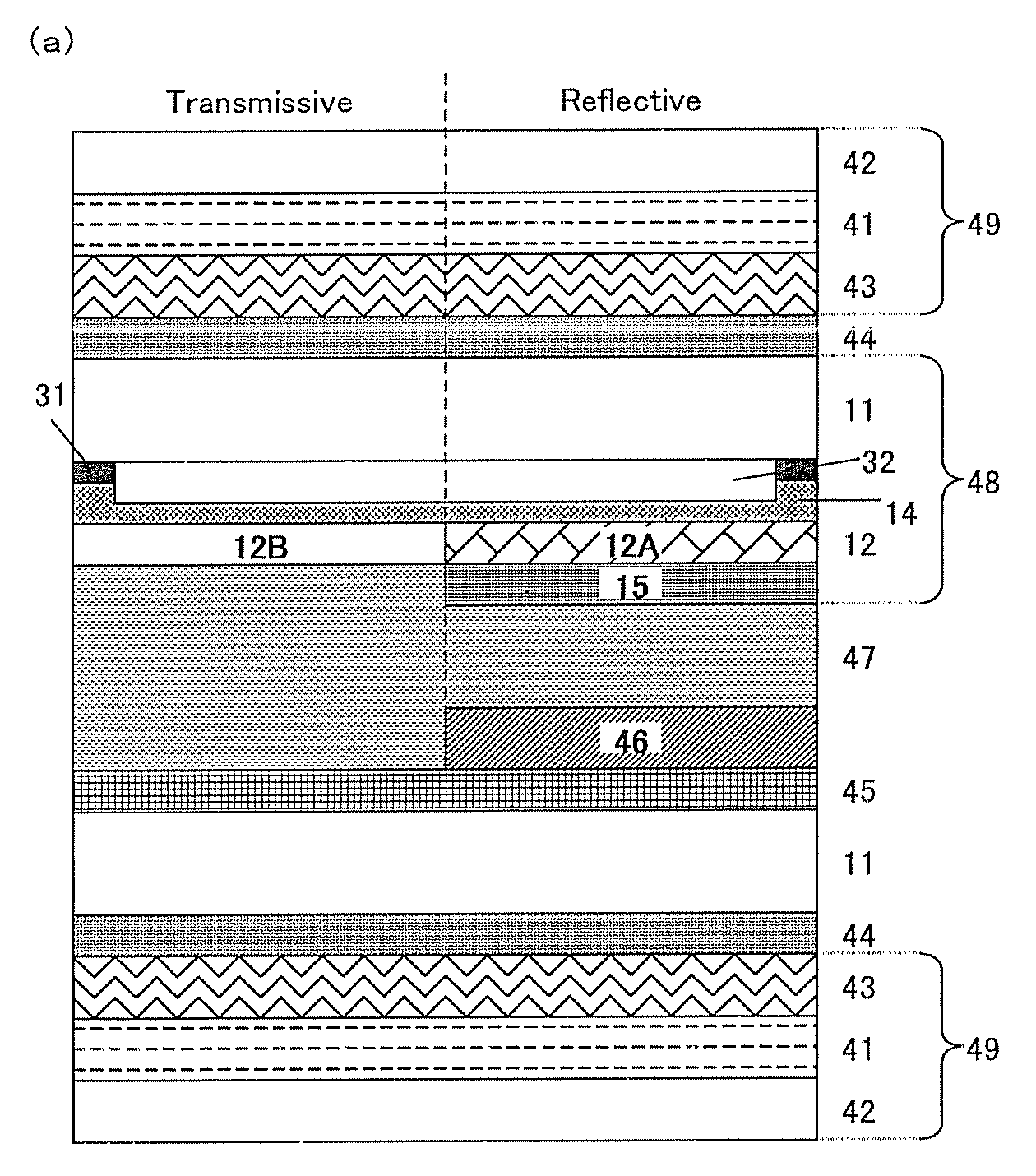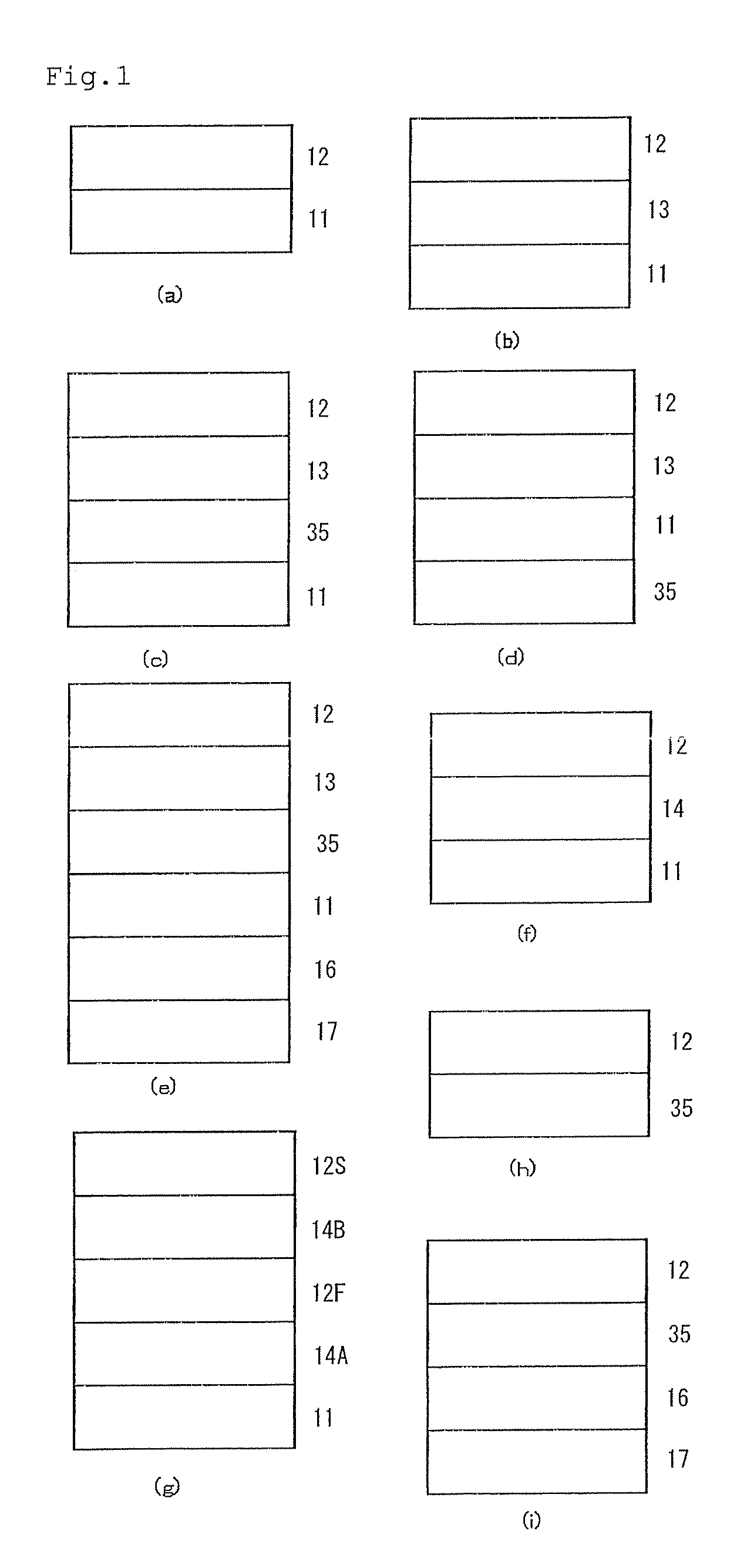Process of Producing Patterned Birefringent Product
a technology of patterned birefringent and product, which is applied in the direction of polarising elements, instruments, other domestic articles, etc., can solve the problems of difficult simple copying with a copier, difficult visible identification, and inability to manufacture, etc., to achieve easy pattern identification, reduce the number of optical compensation sheets of lcd, and produce a high-resolution patterned birefringent product. the effect of excellent heat resistan
- Summary
- Abstract
- Description
- Claims
- Application Information
AI Technical Summary
Benefits of technology
Problems solved by technology
Method used
Image
Examples
example 1
Production of Birefringence Pattern Builder and Patterned Birefringent Product
[0335](Production of Sample TRC-1 for Evaluation of Optically Anisotropic Layer and Transfer Material for Producing Birefringence Pattern TR-1)
[0336]To the surface of a temporary support formed of a 100-μm-thick polyethylene terephthalate film with easily adhesible property (COSMOSHINE A4100 from Toyobo Co., Ltd.), the coating liquid for a dynamic property control layer, CU-1, and the coating liquid for an alignment layer, AL-1, in this order were applied by using a wire bar coater and dried. The obtained layers had dry film thickness of 14.6 μm and 1.6 μm, respectively. Next the coating liquid for optically anisotropic layer, LC-1, was applied to the surface using a wire bar coater, dried under heating at 105° C. on the surface of the film for 2 minutes, to thereby obtain a layer of a liquid crystal phase. The coated layer was then illuminated in the air atmosphere by ultraviolet radiation by using a 160 ...
example 2
Birefringence Pattern Builder with Plural Optically Anisotropic Layers Laminated)
(Production of Transfer Material for Producing Birefringence Pattern TR-5)
[0360]Transfer material for producing birefringence pattern TR-5 was produced in a similar manner to that of TR-1 except that the thickness of the optically anisotropic layer was 3.6 μm.
(Production of Birefringence Pattern Builder BPM-5 of the Present Invention)
[0361]A non-alkali glass substrate was cleaned using a rotating nylon-haired brush while spraying a glass cleaner solution conditioned at 25° C. by a shower for 20 seconds. After showered with purified water, the substrate was sprayed with a silane coupling solution (0.3% aqueous solution of N-β-(aminoethyl)-γ-aminopropyl trimethoxysilane, trade name: KBM-603, Shin-Etsu Chemical Co., Ltd.) by a shower for 20 seconds, and then cleaned with a shower of purified water. The obtained substrate was then heated in a substrate preheating heater at 100° C. for 2 minutes.
[0362]The ab...
example 3
Production of Multi-Color Pattern by Repeating Transfer-Light Exposure-Baking Plural Times
(Production of Transfer Material for Producing Birefringence Pattern TR-6)
[0368]Transfer material for producing birefringence pattern TR-6 was produced in a similar manner to that of TR-1 except that the thickness of the optically anisotropic layer was 1.2 μm.
[0369](Production of Multi-Color Birefringence Pattern BP-6 of the Present Invention)
[0370]A non-alkali glass substrate was cleaned using a rotating nylon-haired brush while spraying a glass cleaner solution conditioned at 25° C. by a shower for 20 seconds. After showered with purified water, the substrate was sprayed with a silane coupling solution (0.3% aqueous solution of N-β-(aminoethyl)-γ-aminopropyl trimethoxysilane, trade name: KBM-603, Shin-Etsu Chemical Co., Ltd.) by a shower for 20 seconds, and then cleaned with a shower of purified water. The obtained substrate was then heated in a substrate preheating heater at 100° C. for 2 mi...
PUM
| Property | Measurement | Unit |
|---|---|---|
| retardation disappearance temperature | aaaaa | aaaaa |
| temperature in-plane retardation | aaaaa | aaaaa |
| temperature | aaaaa | aaaaa |
Abstract
Description
Claims
Application Information
 Login to View More
Login to View More - R&D
- Intellectual Property
- Life Sciences
- Materials
- Tech Scout
- Unparalleled Data Quality
- Higher Quality Content
- 60% Fewer Hallucinations
Browse by: Latest US Patents, China's latest patents, Technical Efficacy Thesaurus, Application Domain, Technology Topic, Popular Technical Reports.
© 2025 PatSnap. All rights reserved.Legal|Privacy policy|Modern Slavery Act Transparency Statement|Sitemap|About US| Contact US: help@patsnap.com



